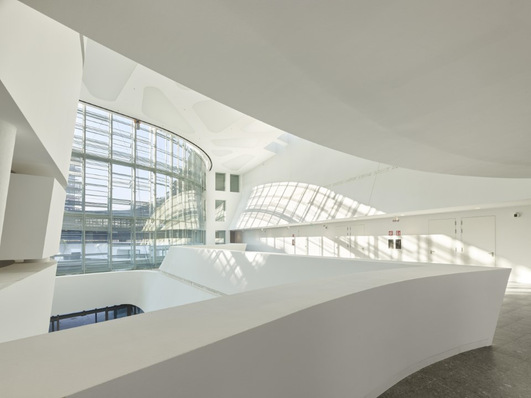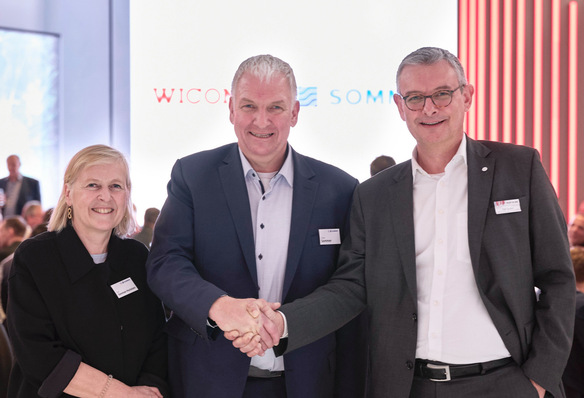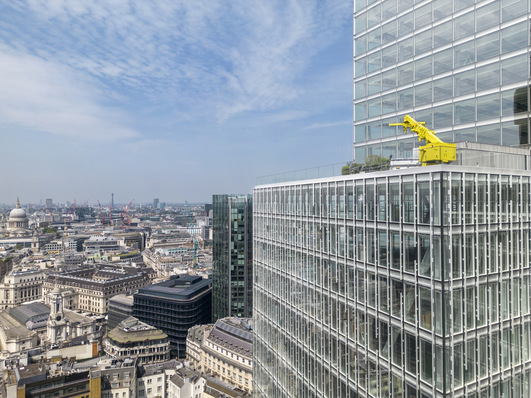The location of the Augustinerhof in Nuremberg between tourist attractions and the neighbouring buildings also posed a challenge for the clients and architects. For the Augustinerhof was to fit into a rich ensemble of listed buildings and at the same time set a contemporary accent.
Thus, the facade was clad in light-coloured concrete block and fitted with dark mansard roofs to match the historic surroundings. Offset dormers interlock the facade with the roof surfaces and pick up on the scale and varying heights of the adjacent buildings.
Optimal use of daylight through high light transmission
The most important tenants in the new Augustinerhof are the Hotel Karl-August and the Deutsches Museum, whose latest branch in Nuremberg opened its doors in mid-September 2021.
In the branch, "technology is made tangible", as the description says. In concrete terms, this means: no showcases, but haptically tangible exhibits and experiments to participate in; people are to be invited. The mighty facade glasses flush with the outside also serve this purpose, opening up the museum space to passers-by.
[A sun protection coating for a more neutral appearance]

Isolar Glas Beratung
Anyone looking out through the glass pane has a viewing angle of almost 180 degrees. They are looking through sun protection glass of the type sunbelt D60 from arcon, which was used here as everywhere else in the building complex. Thanks to the high degree of colour neutrality, the coating of the glasses enables a natural perception of the environment.
The sunbelt glasses also have a very good light transmission of 58 per cent and thus ensure optimum use of the daylight inside, even on dull autumn and winter days.
More energy efficiency with the right glass coating
The museum's large window areas have another function: they can also be used to display exhibits. In addition, some of the glass panes can be removed if large exhibits have to be transported in or out by crane. Energy efficiency requirements also played an important and central role in the selection of the glass: the windows with their large facade glasses not only characterise the appearance of the Augustinerhof, but also ensure low energy costs all year round, according to the supplier.

Isolar Glas Beratung
"The multifunctional coating of the sunbelt glasses allows a high proportion of visible light to pass through. The sun's infrared radiation, on the other hand, is largely reflected," explains Hermann Dehner, product manager at arcon. This prevents the rooms from heating up too much in the summer months, which reduces the time the air-conditioning system has to be used. At the same time, the glass coating minimises heat loss in the winter months. "This results in an optimised indoor climate all year round," says Dehner.
How arcon coatings help to meet KfW requirements
The approximately 2000 quare metres of sunbelt D60 solar control glass in the Augustinerhof, helped to meet the KfW requirements for energy efficiency and the construction of the building complex was supported by the development bank. Depending on the size of the window, different glass thicknesses were used. Visually, the differences are not noticeable; all the windows have a uniform appearance.
[Better mobile phone reception indoors thanks to special glass coating]
Sound insulation also played a role in the decision to use arcon glass. However, with a rather surprising background. The measurements showed that it was not the traffic noise that was disturbing. Rather, the birds on the banks of the Pegnitz were the decisive factor, according to Grunwald. But the sunbelt glasses proved to be a suitable solution for this challenge as well.
arcon coating makes mechanical sun shading unnecessary
Staab Architekten point out another advantage that spoke in favour of the sunbelt glasses: "Thanks to the colour-neutral sun shading coating, additional external shading systems could be dispensed with during construction."
This not only reduced construction costs, but also running costs. This eliminates costs that arise with mechanical sun shading due to regular maintenance work or when defective parts have to be replaced.













